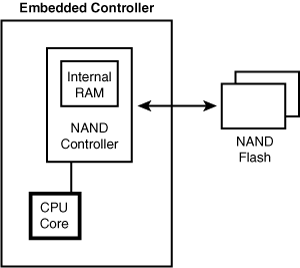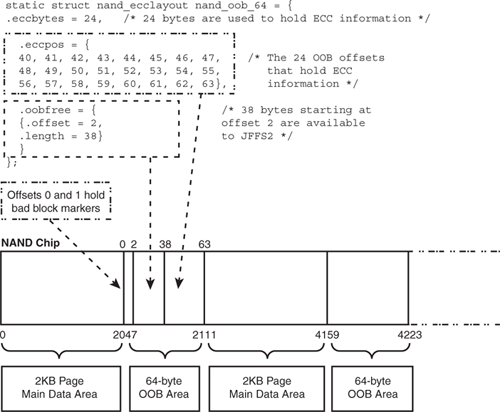Understanding Memory Technology Devices in Embedded Linux
转:
NAND Chip Drivers
NAND technology users such as USB pen drives, DOMs, Compact Flash memory, and SD/MMC cards emulate standard storage interfaces such as SCSI or IDE over NAND flash, so you don't need to develop NAND drivers to communicate with them.5 On-board NAND flash chips need special drivers, however, and are the topic of this section.
As you learned previously in this chapter, NAND flash chips, unlike their NOR counterparts, are not connected to the CPU via data and address lines. They interface to the CPU through special electronics called a NAND flash controller that is part of many embedded processors. To read data from NAND flash, the CPU issues an appropriate read command to the NAND controller. The controller transfers data from the requested flash location to an internal RAM memory, also part of the controller. The data transfer is done in units of the flash chip's page size (for example, 2KB). In general, the denser the flash chip, the larger is its page size. Note that the page size is different from the flash chip's block size, which is the minimum erasable flash memory unit (for example, 16KB). After the transfer operation completes, the CPU reads the requested NAND contents from the internal RAM. Writes to NAND flash are done similarly, except that the controller transfers data from the internal RAM to flash. The connection diagram of NAND flash memory on an embedded device is shown in Figure 17.3.

Figure 17.3 NAND flash connection.
Because of this unconventional mode of addressing, you need special drivers to work with NAND storage. MTD provides such drivers to manage NAND-resident data. If you are using a supported chip, you have to enable only the appropriate low-level MTD NAND driver. If you are writing a NAND flash driver, however, you need to explore two datasheets: the NAND flash controller and the NAND flash chip.
NAND flash chips do not support automatic configuration using protocols such as CFI. You have to manually inform MTD about the properties of your NAND chip by adding an entry to thenand_flash_ids[] table defined in drivers/mtd/nand/nand_ids.c. Each entry in the table consists of an identifier name, the device ID, page size, erase block size, chip size, and options such as the bus width.
There is another characteristic that goes hand in hand with NAND memory. NAND flash chips, unlike NOR chips, are not faultless. It's normal to have some problem bits and bad blocks scattered across NAND flash regions. To handle this, NAND devices associate a spare area with each flash page (for example, 64 bytes of spare area for each 2KB data page). The spare area contains out-of-band (OOB) information to help perform bad block management and error correction. The OOB area includes error correcting codes (ECCs) to implement error correction and detection. ECC algorithms correct single-bit errors and detect multibit errors. The nand_ecclayout structure defined ininclude/mtd/mtd-abi.h specifies the layout of the OOB spare area:
struct nand_ecclayout {
uint 32_t eccbytes;
uint32_t eccpos[64];
uint32_t oobavail;
struct nand_oobfree oobfree[MTD_MAX_OOBFREE_ENTRIES];
};
In this structure, eccbytes holds the number of OOB bytes that store ECC data, and eccpos is an array of offsets into the OOB area that contains the ECC data. oobfree records the unused bytes in the OOB area available to flash filesystems for storing flags such as clean markers that signal successful completion of erase operations.
Individual NAND drivers initialize their nand_ecclayout according to the chip's properties. Figure 17.4illustrates the layout of a NAND flash chip having a page size of 2KB. The OOB semantics used by the figure is the default for 2KB page-sized chips as defined in the generic NAND driver,drivers/mtd/nand/nand_base.c.

Figure 17.4 Layout of a NAND flash chip.
Often, the NAND controller performs error correction and detection in hardware by operating on the ECC fields in the OOB area. If your NAND controller does not support error management, however, you will need to get MTD to do that for you in software. The MTD nand_ecc driver (drivers/mtd/nand/nand_ecc.c) implements software ECC.
Figure 17.4 also shows OOB memory bytes that contain bad block markers. These markers are used to flag faulty flash blocks and are usually present in the OOB region belonging to the first page of each block. The position of the marker inside the OOB area depends on the properties of the chip. Bad block markers are either set at the factory during manufacture, or by software when it detects wear in a block. MTD implements bad block management in drivers/mtd/nand/nand_bbt.c.
The mtd_partition structure used in Listing 17.1 for the NOR flash in Figure 17.2 works for NAND memory, too. After you MTD-enable your NAND flash, you can access the constituent partitions using standard device nodes such as /dev/mtd/X and /dev/mtdblock/X. If you have a mix of NOR and NAND memories on your hardware, X can be either a NOR or a NAND partition. If you have a total of more than 32 flash partitions, accordingly change the value of MAX_MTD_DEVICES ininclude/linux/mtd/mtd.h.
To effectively make use of NAND storage, you need to use a filesystem tuned for NAND access, such as JFFS2 or YAFFS2, in tandem with the low-level NAND driver. We discuss these filesystems in the next section.
Understanding Memory Technology Devices in Embedded Linux的更多相关文章
- Linux MTD (Memory Technology Device) subsystem analysis -For Atheros char device
Linux MTD (Memory Technology Device) subsystem analysis For Atheros char device 读了Linux MTD 源代码分析 对这 ...
- (转)Understanding Memory in Deep Learning Systems: The Neuroscience, Psychology and Technology Perspectives
Understanding Memory in Deep Learning Systems: The Neuroscience, Psychology and Technology Perspecti ...
- 【转载】关于Embedded Linux启动的经典问题
转载自:http://linux.chinaunix.net/techdoc/install/2009/04/13/1107608.shtml 发信人: armlinux (armlinux), 信区 ...
- Understanding Memory Management(2)
Understanding Memory Management Memory management is the process of allocating new objects and remov ...
- Qt for Embedded Linux
1. Qt for Embedded Linux http://doc.qt.io/qt-5/embedded-linux.html 2. Installing Qt for Embedded Lin ...
- 构建自己的embedded linux系统
[教程]使用buildroot完全自定义自己的embedded linux系统(nand)http://www.eeboard.com/bbs/thread-38377-1-1.html [教程] [ ...
- [转]A Guide To using IMU (Accelerometer and Gyroscope Devices) in Embedded Applications.
原文地址http://www.starlino.com/imu_guide.html Introduction There’s now a FRENCH translation of this art ...
- Memory Leak Detection in Embedded Systems
One of the problems with developing embedded systems is the detection of memory leaks; I've found th ...
- How to Add Memory, vCPU, Hard Disk to Linux KVM Virtual Machine
ref: https://www.thegeekstuff.com/2015/02/add-memory-cpu-disk-to-kvm-vm/ In our previous article of ...
随机推荐
- 八、ISP 接口隔离原则
ISP应用的场景是某些类不符合SRP原则,但使用这些类的客户端应该根据它们的父类来使用(我感觉这句话应该改为:客户端应该根据它们的抽象类\接口来使用它们),而不是直接使用它们. 定义: 客户端不应该依 ...
- ZooKeeper客户端 zkCli.sh 节点的配额设置
首先使用 zkCli.sh 连接上ZooKeeper服务器 配额设置命令格式如下: setquota -n|-b val path -n:val设置子节点个数 -b:val设置节点的数据长度 如果我们 ...
- MapReduce架构
主从结构 主节点:JobTracker(一个) 从节点:TaskTrackers(多个) JobTracker: 接收客户提交的计算任务 把计算任务分配给TaskTrackers执行 监控TaskTr ...
- 【bzoj3444】最后的晚餐 并查集
题目描述 n个人排成一排,有m个条件,第i个条件要求ai和bi相邻,求方案数. 输入 输入有m+1行,第一行有两个用空格隔开的正整数n.m,如题所示.接下来的m行,每一行有两个用空格隔开的正整数,第i ...
- C# 在子窗体调用父窗体的值(转)
1.在父窗体中 public delegate void SetVisiableHandler();//定义委托类型 注意此委托定义在namespace下一级,在form类外 private void ...
- 纪中集训总结 && 新学期目标
于是紧接着又发了第二篇. 关于这次去完纪中以后的感想,写完后总觉得少了些什么,因此就发一篇小目标集合来凑数补充一下吧. Part I:图论 这方面我去之前就是很有自信,事实证明像基础的最短路.生成树什 ...
- 【HDU 3336 Count the string】
Time Limit: 2000/1000 MS (Java/Others) Memory Limit: 32768/32768 K (Java/Others)Total Submission( ...
- bzoj2693 莫比乌斯反演
Description Hint T <= 10000N, M<=10000000 https://wenku.baidu.com/view/fbec9c63ba1aa8114431d ...
- 7月12号day4总结
今天学习过程和总结 封装JDBC在src/main/java下com.neuedu下utils建立JDBCUilt.java 进行封装,基于框架的开发要么继承父类要么实现接口 一个方法里只能有一个动态 ...
- Windows录音API学习笔记--转
Windows录音API学习笔记 结构体和函数信息 结构体 WAVEINCAPS 该结构描述了一个波形音频输入设备的能力. typedef struct { WORD wMid; 用于波形 ...
